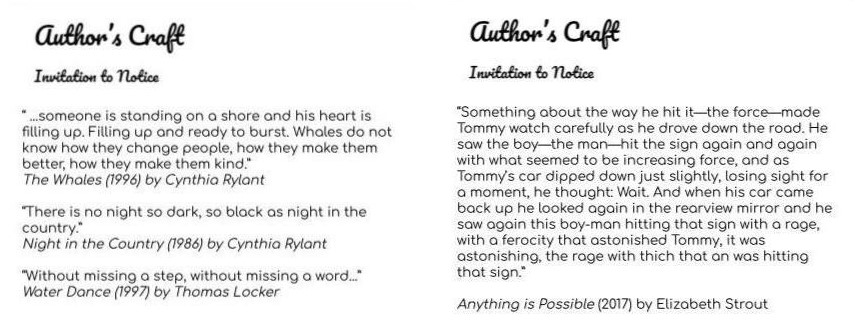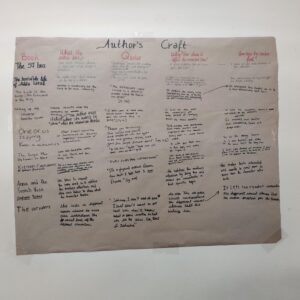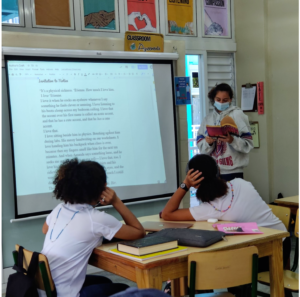How to Hook High School Readers Through the Study of Author’s Craft
In his tongue in cheek article How to Create Non-Readers, Alfie Kohn lists all the things teachers tend to do to kill students’ love of reading; he mentions strategies like having them fill in reading logs or writing essays about the novels they read. As students move into high school, many of them seem to be reading less, so it’s even more important for teachers to find ways to hook readers while still teaching reading analysis skills. How do we find this magical balance? Reading like a writer through the study of “author’s craft” to the rescue!
One of our 10th grade Language Arts teachers, Angeliki, was looking for a focus for her independent reading unit — something that would help students continue to learn, but that wouldn’t detract from the sheer joy of reading. I shared one of my favourite writing books of all time, Wondrous Words by Katie Wood Ray, with her. Although this book is written for elementary classrooms, the ideas that Katie shares about “author’s craft” can be used in secondary with great impact on both reading and writing.
As Angeliki browsed through the book. She loved the idea of having students “read like a writer”. When students read like a reader they look at the “what” of the writing. What is the writer trying to say? This includes theme and character analysis. But when they read like a writer they look at the “how” of the writing. How is the writer getting their message across? This leads into a study of author’s craft, where students discover the tools authors use to catch their attention and analyze the impact they have on them as a reader.
Angeliki decided to scaffold her students’ learning by beginning with whole group lessons before moving on to having them work individually in their independent reading and finally using author’s craft in their writing. These are the three steps she took:
Teaching author’s craft through invitations to notice
- Angeliki began by sharing interesting writing excerpts that displayed author’s craft and asking her students what they noticed. The author’s craft may be a literary device like alliteration, but it could also be the use of a short sentence that stands alone in a paragraph at the end of a chapter, or it could be the use of proper nouns (ex: “Gouda and Roquefort” instead of “cheeses”). Basically, any tool authors use to “craft” their writing.
- First students identified the author’s craft that they noticed in the text. They named the craft (either an existing literary device or a made-up name like: “short, short, long sentences” to describe sentence length variation)
- Then Angeliki asked them to analyze why the author used it. She asked them to explain how the writing strategy impacted them. How did it make them feel as a reader?
- Finally, they added the different tools they discovered to a classroom anchor chart.
Looking for craft in independent reading novels
-
As students read their independent reading novels, they started by identifying the author’s craft strategies that they had already discovered in class with Angeliki.
- Then they began to look for new tools… and it was exciting.“Oh, look at this! Kwame Alexander makes up new words: ‘The chains are JINGALING, ringaling and SWINGALING.’ (p.222)”
- Once students discovered a move that an author made, Angeliki empowered her students by having them teach it to the class.
Using author’s craft in their own writing
- And then the best thing happened! As students became more familiar with a variety of author’s craft moves, their own writing became so much better. When students learn to use simple writing strategies like using a period between single words for emphasis, they begin to see themselves as writers, going back to explicitly craft their pieces to impact the reader.
- Kids began to use author’s craft techniques everywhere. Angeliki asked students to use some of these strategies in their creative writing, but then, unbidden, they began to use them in essays and reading response assignments too. And, much to Angeliki’s surprise, author’s craft even showed up in messages and emails students sent to her.
- This year, a former 10th grade student told Angeliki, “Thank you for teaching us author’s craft last year — it’s made me a much better writer. But also, a better reader. I’m constantly on the lookout for the way an author impacts me with word choice and sentence structure.”
A strategy for a unit became a year-long study
Although Angeliki had intended to make this a teaching point in one of her independent reading units, it naturally permeated through her teaching and learning all year long. As students sat in a circle listening to her read aloud from a shared reading book, a student would pipe up with, “Oh look, look what the author’s doing here…..”
It. Was. Magical.
Resources
Wondrous Words by Katie Wood Rae (chapter 7: An Invitation to My Library: The Craft of Text Structure and chapter 8: Another Invitation to My Library: Ways with Words are especially useful).
“Reading Like a Reader, Reading Like a Writer” by Steve Peha




Leave a comment